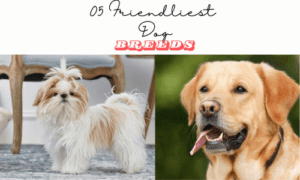Introduction
There’s more to choosing the perfect dog than merely falling in love with a gorgeous face or a wagging tail when it comes to dog ownership. Choosing a low-maintenance dog breed is a smart decision for many pet owners, especially those with hectic schedules or little time for thorough grooming and training.
However, what precisely qualifies as a low-maintenance dog breed, and which varieties fall into this category? Join us as we explore the traits, instances, and considerations for choosing the ideal partner as we dive into the world of low-maintenance dogs.
Table of Contents
Characteristics of Low-Maintenance Dog Breeds:
1. Grooming Requirements:
Low-maintenance dog breeds are perfect for owners who would rather spend less time combing and grooming their pets because they usually require less upkeep. Since the coats of these breeds are frequently short, little to no style or clipping is necessary. They also often lose less fur, which lowers the need for frequent maintenance and lowers the possibility of allergies for owners who are more sensitive.
2. Exercise Needs:
All dogs need exercise on a daily basis to be healthy and happy, but low-maintenance breeds tend to be less energetic and require less activity than their more active counterparts. These breeds make good companions for single people or families with limited time for outdoor activities because they are comfortable with short daily walks and indoor fun.
3. Trainability:
Low-maintenance dog breeds are renowned for being intelligent and simple to teach, which makes them obedient friends and quick learners. Some breeds are particularly good at adapting and following directions, which makes training easier and more pleasurable for both the dog and the owner, whether the dog is learning simple commands or engaging in more complex training exercises.
4. Health Considerations:
It’s important to take into account the breed’s general health as well as its vulnerability to common health problems when selecting a low-maintenance dog breed. Choosing dog breeds with strong health histories and low genetic susceptibilities to inherited diseases will help guarantee a long and healthy life for your furry friend. Maintaining the health and wellbeing of your dog requires routine veterinary care, which includes vaccinations and preventative measures.
Low-Maintenance Dog Breeds:
1. Labrador Retriever

One of the most popular low-maintenance dog breeds is the Labrador Retriever, who is known for their gentle attitude and kind demeanour.
Labs have short, water-resistant coats that require little maintenance; regular brushing is all that’s needed to keep their fur looking nice.
They are wonderful family pets and friends for people of all ages because they are also very trainable and adaptive.
2. Cavalier King Charles Spaniel

Cavalier King Charles Spaniels are another great option for people looking for a low-maintenance canine companion because of their exquisite appearance and loving nature.
Cavaliers are generally easy to groom due to their smooth, medium-length coats, which require frequent brushing to prevent mats and tangles.
Additionally, they are gregarious and flexible, thriving in a variety of residential settings and family configurations.
3. French Bulldog

French Bulldogs are surprisingly low-maintenance dogs that are perfectly adapted to apartment living and metropolitan lifestyles, despite their muscular builds and expressive expressions.
Frenchies require less maintenance due to their short, silky coats and low shedding, making them very easy to take care of.
In addition, they are flexible and loving, developing close relationships with their owners and taking pleasure in indoor activities.
4. Shih Tzu

Shih Tzus make excellent friends who fill their owners with happiness and laughter. They are distinguished by their opulent, flowing coats and lively dispositions.
Though frequent brushing and grooming are necessary to avoid mats and tangles in their long, silky coats, Shih Tzus are generally low-maintenance canines that thrive on affection and attention.
They are extremely lovable and adaptive, which makes them the perfect companions for anyone looking for a devoted and caring animal.
5. Boston Terriers

Boston Terriers make lovely and loving pets who are ideal for indoor living, especially with their tuxedo-like markings and expressive eyes.
They are low-maintenance dogs for busy owners because of their short, smooth coats, which require little upkeep.
Because of their lively dispositions and love of company, Boston Terriers are excellent companion animals for both individuals and families.
6. Chihuahua

Even though they are small dogs, Chihuahuas have big personalities and are great low-maintenance companions for city people and flat dwellers.
Chihuahuas are low maintenance dogs that only need the occasional brushing to maintain healthy fur because of their short coats and low maintenance requirements.
They are the perfect companions for anyone looking for a tiny but devoted dog since they are devoted and caring animals who build close relationships with their owners.
7. Dachshund

Dachshunds, who are characterised by their unusually long bodies and lively dispositions, are playful, loving dogs who enjoy spending time with people.
Dachshunds require routine brushing to avoid mats and tangles in their short, silky coats, which make them comparatively low-maintenance canines.
Because of their intelligence and adaptability, they are devoted companions and wonderful family dogs for anyone looking for a canine friend with personality.
8. Whippet

Whippets are sleek, attractive dogs that are renowned for their quickness and agility. Surprisingly low-maintenance dogs, Whippets are comfortable with daily walks and indoor fun despite their athletic prowess.
Whippets have short, smooth coats that require little maintenance; in fact, their coats just need to be brushed occasionally to stay in good condition.
They are kind and loving companions that build close relationships with their owners, which makes them perfect for households with active members.
9. Basenji

Basenjis are intelligent, autonomous canines that make great low-maintenance companions for seasoned pet owners.
They are sometimes referred to as the “barkless dog” because of their distinctive vocalisations. Basenjis are comparatively easy to groom, needing only the occasional brushing to keep their coats in good condition due to their short, smooth coats and low shedding.
They are wonderful companions for anyone looking for a canine friend with a little bit of exotic flair because they are devoted and loving animals who build great relationships with their families.
10. Italian Greyhound

Italian Greyhounds are beautiful, friendly, and low-maintenance dogs that are ideal for anyone looking for a compact, energetic dog friend. They are sleek and slim. Italian Greyhounds have short coats that require little maintenance; all they need is the occasional brushing to keep their coats looking nice.
They are smart, sensitive animals that like human company, which makes them the perfect choice for anyone looking for a devoted and loving dog buddy.
These are just a few instances of low-maintenance dog breeds that provide their owners with happiness, devotion, and friendship. Every lifestyle and desire can be accommodated by a low-maintenance dog breed, whether it’s a larger, more active type or a tiny lap dog.
You can choose the ideal canine friend that will enrich and fulfil your life for years to come by taking into account aspects like temperament, exercise requirements, grooming requirements, and personal preferences.
Factors to Consider When Choosing a Low-Maintenance Dog Breed
1. Lifestyle Compatibility
Think about your lifestyle, housing environment, and daily schedule when choosing a low-maintenance dog breed. Whether you live a busy metropolitan life or prefer a slower pace in a suburban or rural location, pick a breed that blends effortlessly into your lifestyle and can adjust to your schedule and activities.
2. Living Environment
Consider the space that you have available for your dog and the surroundings in which you live. Certain breeds that require less care are more appropriate for apartment living, but other breeds do well in houses with large yards and outside spaces for play and exercise. Pick a breed that will feel happy and at ease in your home after taking your living situation into account.
3. Allergies or Sensitivities
Select a hypoallergenic, low-maintenance dog breed with less shedding if you or any family members are allergic to or sensitive to pet dander. Owing to their non-shedding coats and less production of dander, breeds including Maltese, Poodles, and Bichon Frises are popular alternatives for allergy sufferers.
4. Personal Preferences
It’s ultimately up to you to decide which low-maintenance dog breed best suits your tastes, way of life, and expectations as a pet owner. To select a breed that best suits your tastes and way of life, take into account aspects like size, temperament, energy level, and care needs.
Conclusion
In conclusion, for pet owners looking for a furry buddy that blends in well with their hectic lives, low-maintenance dog breeds provide the ideal balance of friendship, convenience, and joy. There are many different low-maintenance breeds to pick from, each with their own special qualities and charms, whether you’re looking for a larger, more active type or a tiny lap dog. Finding the ideal low-maintenance dog breed that will enrich your life for years to come may be achieved by taking into account several criteria like grooming requirements, activity needs, trainability, health considerations, and individual preferences.
FAQs
1. What exactly does "low-maintenance" mean when it comes to dog breeds?
“Low-maintenance” describes dog breeds that, in comparison to other types, require less training, grooming, and activity. With their short coats, little shedding, moderate energy levels, and ease of training, these breeds are great companions for people who lead busy lives or don’t have much time for intensive pet care.
2. Are all low-maintenance dog breeds hypoallergenic?
It should be noted that not all low-maintenance dog breeds are hypoallergenic, even if some of them are because of their minimal shedding and decreased generation of dander. It is critical to investigate particular breeds and speak with vets or breeders to ascertain whether they are suitable for people who have dander allergies or sensitivities.
3. Do low-maintenance dog breeds still require regular veterinary care?
Yes, frequent veterinarian care is necessary to maintain the health and well-being of low-maintenance breeds of dogs, just like it is for any other dog. Low-maintenance breeds must have regular vaccines, yearly physicals, dental care, and preventive treatments like flea and tick repellent to ensure their long-term health and happiness.
4. Are low-maintenance dog breeds suitable for families with children?
Yes, families with kids make great companions from a variety of low-maintenance dog breeds. Family with children can benefit greatly from the calm and amiable temperament of some breeds, like Labrador Retrievers, Golden Retrievers, and Cavalier King Charles Spaniels. Nonetheless, it is imperative to oversee dog-young child interactions and educate them on how to treat and take care of their pets.
5. Can low-maintenance dog breeds live in apartments or small living spaces?
Yes, apartments and other tiny places are ideal for many low-maintenance dog breeds. Compact in stature and low maintenance needs, breeds like French Bulldogs, Shih Tzus, and Pugs are ideal family pets for people or single people residing in cities or apartments. To keep these breeds from becoming bored and to enhance their general wellbeing, constant exercise and mental stimulation are necessary.
6. Are there any disadvantages to owning a low-maintenance dog breed?
There are several possible drawbacks to take into account, even if low-maintenance dog breeds have many benefits, such as little grooming demands and moderate exercise requirements. It is important to do extensive breed study and be ready for any obstacles because certain low-maintenance breeds might be more prone to certain health conditions or behavioral concerns. Furthermore, people who lead very active lives or are looking for a dog for a particular activity, like agility or competitive sports, could find that low-maintenance breeds are not the best fit.
7. How can I ensure that my low-maintenance dog stays healthy and happy?
Regular exercise, mental stimulation, a balanced diet, and regular veterinary treatment can help your low-maintenance dog remain healthy and happy. Give your dog lots of love, care, and devotion while also spending quality time together, training, and socializing. You may contribute to making your dog’s life meaningful and enriching by attending to its physical, mental, and emotional needs.
- You might be interested in reading this post as well

Shielding Homes: The Vital Roles of Protective Dog Breeds

“Unveiling the Charm: Top 05 Friendliest Dog Breeds Revealed”

“The Ultimate Guide to Fastest Dog Breeds for Running”

08 Adorable Fluffy Dog Breeds That Will Melt Your Heart

“Faithful Companions: Discovering the Most Loyal Dog Breeds”

